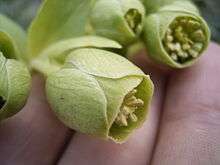tepal
English

Hellebore flowers normally have no true petals: the apparent petals are sepals or "tepals"
Pronunciation
- enPR: tĕp'(ə)l, IPA(key): /ˈtɛp(ə)l/ or IPA(key): /ˈtiːp(ə)l/
Noun
tepal (plural tepals)
- (botany) Any component of the perianth (outermost whorls of flower parts, not involved in reproduction), especially when the components are not distinguished into sepals and petals.
- 1982, H. Q. Varekamp (translator and editor), Z. Botschantzeva, Tulips: Taxonomy, Morphology, cytology, phytogeography and physiology, page 27,
- In Tulipa the pubescent tips of the tepals are quite interesting in particular those of T. fosteriana. The top of the tepal is initiated and develops before the reflexed, lateral parts.
- 2001, Barbara W. Ellis, Taylor's Guide to Bulbs, page 400,
- The species bears creamy white flowers with a yellow base and tepals often streaked with rose-pink.
- 2013, Margarita V. Remizowa, Dmitry D. Sokoloff, Paula J. Rudall, 8: Patterns of bract reduction in racemose inflorescences of early-divergent monocots, Paul Wilkin, Simon J. Mayo (editors), Early Events in Monocot Evolution, page 194,
- In our material of T. bulbosa, the abaxial outer tepal was larger at its inception than the lateral ones (Fig 8.4C), whereas the primordia of the outer tepals are of nearly equal size in both T. barrelieri (Fig 8.5E) and T. palustris (not shown).
- 1982, H. Q. Varekamp (translator and editor), Z. Botschantzeva, Tulips: Taxonomy, Morphology, cytology, phytogeography and physiology, page 27,
Translations
This article is issued from
Wiktionary.
The text is licensed under Creative
Commons - Attribution - Sharealike.
Additional terms may apply for the media files.